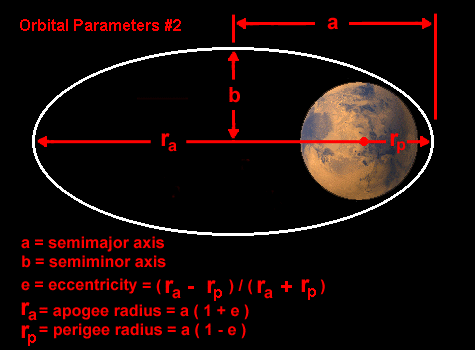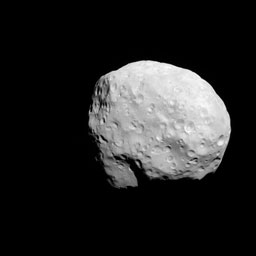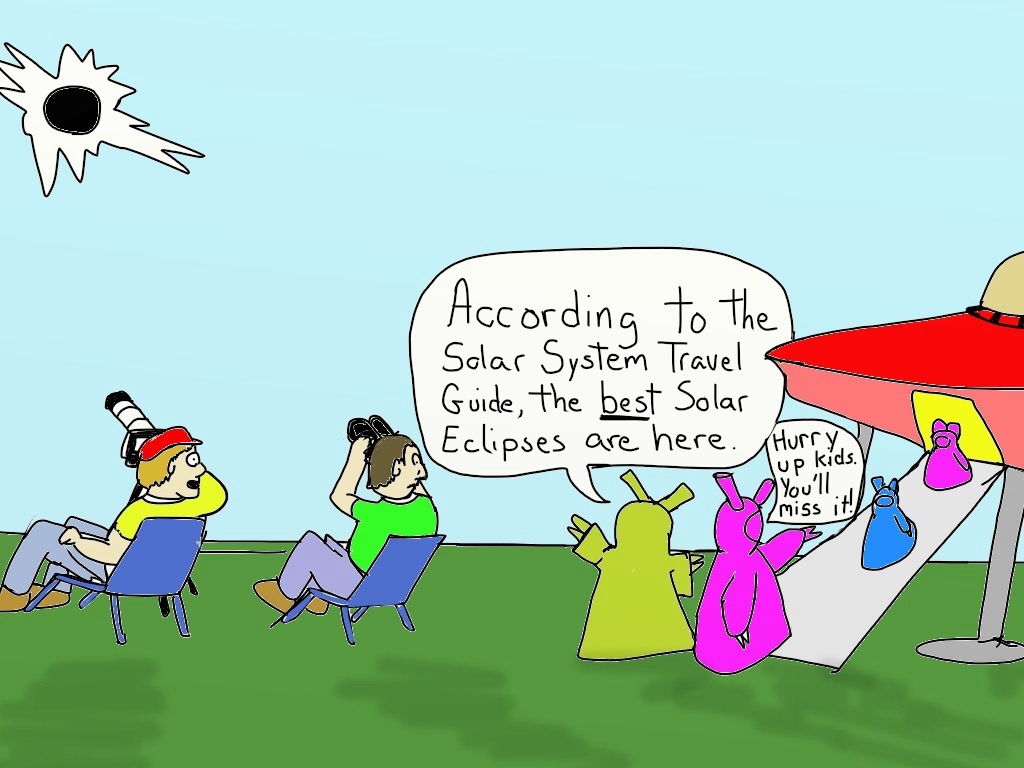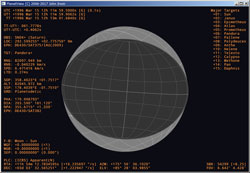
|
www.eclipse-chasers.com Do other planets see solar eclipses? Author: Bill Kramer Last update: Wednesday, 18-Apr-2018 12:36:09 EDT |
Eclipse Chaser
(noun) - Anyone that wants to see a total solar eclipse.  Search Eclipse Chasers Site
Search Eclipse Chasers Site |
Is the Earth the only planet in our solar system to enjoy a perfect eclipse alignment?
-by Bill Kramer
This investigation was inspired by questions from many people concerning the uniqueness of solar eclipses in the solar system. Many eclipse chasers, including myself, like to point out the fact that solar eclipses on Earth are the result of an amazing coincidence. The nearly matching angular sizes of the Moon and Sun as they appear from the surface of Earth results in a dazzling display of the solar corona. It really is a sight to behold and the comment often comes up about how lucky we are on Earth to see it. But is it really that unique and rare?
A simple quest was started to figure out a way to learn just how rare solar eclipses are in the solar system. I had seen the shadows of Jupiter's largest moons against the cloud tops so I knew it was possible. I wondered, how many other moons in the solar system do that? And just how many of these moons create an eclipse that is a near perfect fit? This lead to an idea. What if I was to sample the known moons in the solar system and look for matches in angular sizes? Would I find any other moons that can create the same amazing coincidence as we see here on Earth?
Moons tested
There are currently over 180 known natural satellites in the solar system. Of these moons, several are large enough to be rounded and some even host an atmosphere. This investigation included 141 moons in orbit about the planets in the table below. Moons orbiting other objects such as Pluto and large asteroids were not included. The data source for the sizes and orbital data of the moons can be found at: NASA Planetary Fact Sheets.
The following planets with moons in our solar system are part of the study.
| Planet name | Radius (KM) | Moons | Distance to Sun (KM) |
Angular Size (Degrees) |
| Earth | 6371 | 1 | 150,000,000 | 0.53147 |
| Mars | 3390 | 2 | 228,000,000 | 0.34965 |
| Jupiter | 69911 | 50 | 778,000,000 | 0.10247 |
| Saturn | 58232 | 53 | 1,427,000,000 | 0.05587 |
| Uranus | 25362 | 27 | 2,870,000,000 | 0.02778 |
| Neptune | 24622 | 8 | 4,497,000,000 | 0.01773 |
For reference, the limits of human eye resolution is about 0.02 degrees. Looking at the table of planets with moons above one can see that the view of the Sun from Saturn is a very small disk. From Uranus and Neptune the Sun appears as a bright dot in the sky to unaided eye. To see any sort of eclipse event from the outer planets will require a modest telescope.
Comparing the angular sizes
Using data from the NASA Planetary Fact Sheets about the moons, a program was created to compare the angular sizes of the moons at the extremes of the orbits. The angular sizes were compared to the angular size of the Sun. The comparisons were accomplished in terms of a ratio. Angular sizes of the moon are divided into the angular size of the Sun. If the ratio is greater than 1.0 meant an annular eclipse event can take place. For ratios less than one, a total eclipse event can take place. If you want to see the table of computations, click here for the Angular Size Comparison Table.

|
The moon's orbital extremes are called periapsis and apoapsis. Periapsis is when the moon is closest . Apoapsis is the farthest distance from the planet. At periapsis the angular size of the moon is larger than apoapsis. For more about orbital parameters, click here. To produce an eclipse that is the most like the Earth-Moon system, |
What did we find out?
Click here to see a list of solar system moons that could cause a solar eclipse like that we see on Earth. At the end of the table generated by the study program you will find the summarized results as follows.
- Found Earth-like eclipse conditions for: Earth/Moon, Saturn/Epimetheus, Saturn/Pandora
- Moons investigated: 141
- Maximum Solar/Moon ratio: 28,954.3
- Minimum Solar/Moon ratio: 0.037332
- Total eclipses: 31 - where the Sun is completely covered at both apoapsis and periapsis.
- Annular eclipses: 107 - where Sun is visible around occulting moon at both apoapsis and periapsis.
- Extreme totals (moon over 2x size of Sun): 30
- Extreme annulars (Sun over 2x size of moon): 104
- Number of very interesting eclipses, where moon appears less than twice the size of the Sun allowing a view of the corona, is 8 with 3 making a near perfect fit (one to one) - annular at apoapsis, total at periapsis.
- Of the moons in the solar system, 22% were total only, 75.9% were annular only and 5.7% are interesting.
The program revealed three moons in our solar system, click for detailed results, that can produce a total solar eclipse when the moon is at periapsis and an annular eclipse at apoapsis. The Earth-Moon system is one of the three. The other two moons that can create eclipses like we see here on Earth are in orbit of Saturn. They are Epimetheus and Pandora. So let's take a closer look at them.
|
|
Pandora is a small satellite in orbit about Saturn. At the equator of Saturn, on the cloud tops, one could potentially see a total solar eclipse or an annular eclipse. The problem is that Pandora is not a near sphere like our Moon (it is described as a flattened potato shape - see image from Casinii mission at left). Tidal influences have the bigger side pointed towards the planet Saturn. I used a radius value for this moon in the analysis program that is the mean of the two smaller dimensions. John Irwin pointed this out and using a program called Planetview, he created a simulation of Pandora eclipsing the Sun. He used an ellipse to represent the moon as seen from Saturn since it appears as a slightly flattened potato. The result is nothing like what we would see here on Earth and is really not a total solar eclipse when the smaller radius value is applied. Note the near perfect fit for the larger radii value, which the investigating program triggered on initially. We can rule out Pandora as a good fit. Pandora is one of the sheppard moons for the F ring of Saturn. It orbits the planet Saturn quickly, once every 15.1 hours. What this means is that any eclipse you might see from the cloud tops of Saturn is going to be VERY quick, a fraction of a second. Given the geometry of the profile, Pandora is NOT a good candidate to consider further as one that can produce an Earth-Like total solar eclipse. To learn more about Pandora, click the image or name above. |

|
Epimetheus is a another small satellite in orbit about Saturn. It is about 72 miles across and also described as potato shaped with the larger side facing the planet Saturn as a result of tidal influences. Taking only 17 hours to orbit Saturn this moon is moving quite fast. An eclipse observed from the cloud tops of Saturn would last less than a second. John Irwin created a simulation of Epimetheus eclipsing the Sun. This moon did not turn up in the initial study. Dave Herald expressed an interest in finding moons that would show the corona so a test was added to see if any of the moons were big enough to obscure the Sun but small enough to see corona around them. John Irwin suggested an additional test to see if eclipse conditions were met at the poles of the planet. By checking the entire range of possible planetary positions, Epimetheus turned out to be a very good candidate. It turns out that this moon creates a solar eclipse that most resembles those seen from Earth. It just happens very fast. So fast that I don't think I will ever complain about how short total solar eclipses are here on Earth. To learn more about the moon Epimetheus, click the image or name above. |
While our results found that the uniquely rare coincidence of angular sizes for a natural moon and the Sun is rare, it is not isolated to just the Earth and Moon. We found two other moons that produce solar eclipses as seen from the cloud tops of Saturn. Out of the 141 moons tested in this study, we found three (including Earth) where nearly perfect eclipse conditions and that was unexpected.
Not unexpected, we did show that eclipses of the Sun as seen from the Earth are truly the best in the solar system.

The purpose of this study was to find out just how many other planetary systems might experience a total solar eclipse. It turns out to be more common than I originally thought. The special circumstances are not all that unique. One could expect to find many solar systems with planets that have moons which can create the same type of solar eclipse effect we see on Earth.
Of course, we eclipse chasers always have known that the BEST total solar eclipses occur on Earth! There isn't any question to that fact!
Acknowledgments: Many thanks to John Irwin and Dave Herald for their input in to this study.
 An annular eclipse event is where the moon is too small to cover the solar disk.
An annular eclipse event is where the moon is too small to cover the solar disk. A total eclipse event is where the moon appears larger than the solar disk.
A total eclipse event is where the moon appears larger than the solar disk.

